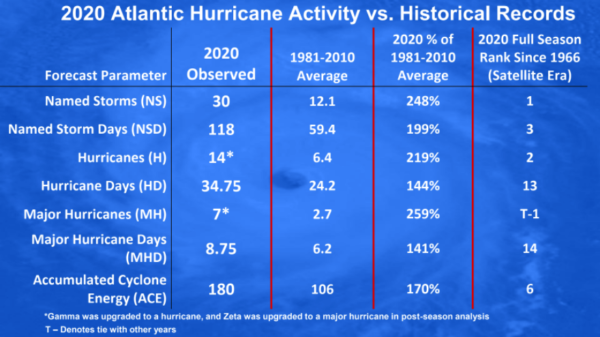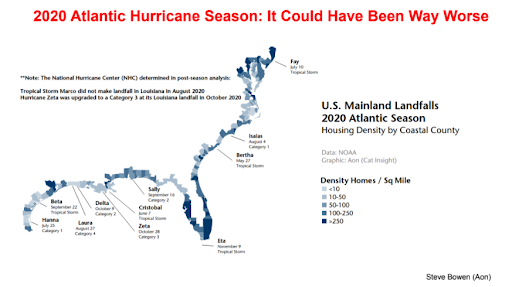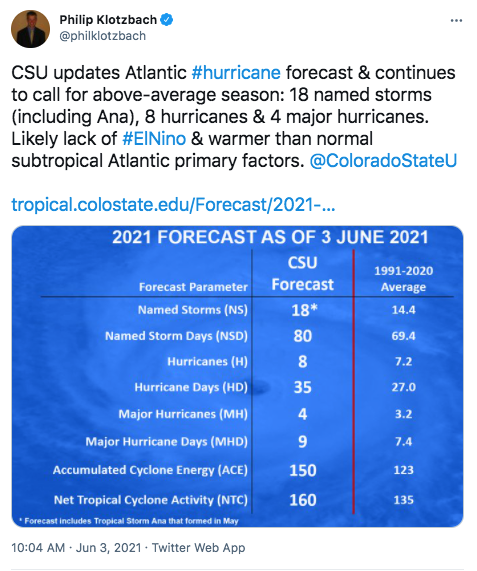A Look Back at Hurricane Season 2020
and Forward to the 2021 Hurricane Forecast
The great Yankee catcher Yogi Berra once said, “It’s tough to make predictions, especially about the future.” This certainly resonates with Dr. Phil Klotzbach, an atmospheric scientist at Colorado State University in Denver.
He’s spent his career to date working on CSU’s annual hurricane forecast for the Atlantic basin, and a great deal of his work is related to calculating and estimating uncertainty. Last month, Dr. Phil joined us for a webinar in which he looked back at hurricane season 2020 and an update on the 2021 Atlantic hurricane forecast.
Here are a few of the key points he shared, as well as an emerging hurricane season trend to watch.
The 2020 Atlantic Hurricane Season in Review
Hurricane season 2020 was extremely active, and the number of observed hurricanes actually increased after the season’s official end on November 30, 2020.
This isn’t entirely unusual: after every hurricane season, the National Hurricane Center reviews the data they’ve collected and checks to see if they made or received any observations after the storm went by that will help them get a better idea as to how strong it actually was.
Last year, Gamma was upgraded from a tropical storm to a hurricane after the end of hurricane season and Delta was upgraded to a major hurricane right before it made landfall in Louisiana, which is why the final tally of named storms is 30, breaking the old record of 28 set back in 2005.

In addition to reflecting on the number of named storms, Klotzbach also looks at Accumulated Cyclone Energy (ACE) of each event, which is an integrated metric that accounts for the frequency, intensity, and duration of storms. That value was also quite high this past year, although it didn’t break any records.
If you live along the Atlantic or Gulf Coast – or if your customers live in these areas – remember that the best way to prepare for the next storm is to ensure you’re at least prepared to weather that last worst storm you saw: click through to read more about how to prepare for hurricane season 2021.
Where to Find the 2021 Atlantic Hurricane Forecast and Updates
Since the webinar on May 18th, CSU has updated their 2021 hurricane predictions to include data from the month of May. It’s worth noting that 90 percent of named storms occur after August 1st every year, so hurricane forecasters provide monthly updates to their predictions throughout the season.
You can find up-to-date forecasts from all major hurricane forecast providers at the Seasonal Hurricane Predictions website, or you can follow your favorite meteorologists, including Dr. Phil, on Twitter.
While the 2021 Atlantic hurricane forecast currently estimates that we’ll see an above-average season, the prediction that we’ll see eight hurricanes is only one part of the story.
The probability that the entire US coastline will see at least one major hurricane landfall (a category 3, 4 or 5) is 69 percent – notably higher than the 52 percent average for the twentieth century.
At National Flood Services, we always recommend preparing for the next hurricane season as though you can be certain to face some kind of hurricane and the flooding that so often comes with these massive storms.
If you’re an agent or insurer, review our five-point preparedness plan before the first storm of the season hits. And if you’re a homeowner yourself, don’t be caught without an emergency plan.
A Trend to Watch in 2021 and Beyond: Storm Concentration in the Western Atlantic
Looking at the 2020 hurricane season in review, the other thing that stands out is just how much storm activity there was in the western part of the Atlantic basin and how many storms intensified in this area.

Why does this matter? When storms form in the western part of the basin, there’s nowhere for them to go, so they’re more likely to cause significant levels of damage, whether they make landfall in the US, the Caribbean, or in Central America. And we certainly saw the impact of this last year as there was tremendous hurricane damage in Nicaragua, Honduras, and Guatemala.
As Dr. Phil said, “In terms of avoiding perspective in a planning perspective, if storms are rapidly intensifying up to almost a landfall, that can pose extremely problematic for getting the population ready for a particular storm event.”
Of the 10 storms that underwent rapid intensification last year, eight of them did so in the Western Atlantic, almost up to a landfall, and again that is extremely problematic from a preparation and mitigation perspective.

The good news is that last year, named storms missed major metropolitan areas, including Hurricanes Delta and Laura, which made landfall just a few miles apart, but far from any large cities or densely inhabited areas of the coastline.
Wherever you live, be sure to get to know your local disaster risk profile before the first storm of the 2021 hurricane season hits.
Blog Articles

